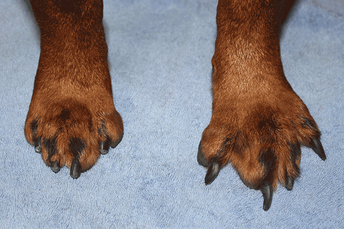Nail and Foot Care
Foot injuries are painful, often difficult to treat, hard to keep clean, and are just an all around pain for both the dog and owner to deal with. Having dealt with multiple foot injuries with our dogs, we want to share a little bit of helpful info on how to prevent these types of injuries. It all starts with basic nail and foot maintenance.
 Trimmed vs Untrimmed Nails
Trimmed vs Untrimmed Nails
We can’t stress enough how important it is to keep your Hokkaido's nails trimmed. We handle all our puppies’ paws and toes from an early age to prepare them for regular trims. Nail trimming starts as early as 2 weeks. From there, we trim every few days to every week depending on how fast our dogs’ nails grow. Every dog is different. The general rule of thumb is to keep nails short enough that you can’t hear them walking on hard surfaces. If you hear a “click click” whenever your dog walks across your hardwood floors... his nails are too long!
When nails are too long, dogs have a harder time gripping on slippery surfaces, their toes splay outward (which severely damages joints), their nails are prone to splitting open, and it can cause painful arthritis and even skeletal damage!
So what happens if you have a dog whose nails are already too long and he doesn’t want them trimmed? There’s two ways you can handle this… strap him to a grooming table, have a friend wrestle him down, hold his paws tightly, and cut; OR slowly desensitize him to the clippers, trimming maybe one or two toes at a time for a few weeks. We've done it both ways, and both the dog and us much prefer the later.
The trick to getting your dog to let you trim his nails is making it a pleasant experience. Seems simple, but if your pup hates having his feet touched then we will have to go a few steps back. Try teaching your dog a “paw” command and rewarding for how long he will keep his paw in your hand. Start fiddling gently with the paw and rewarding. Once your dog is comfortable with you messing with his feet and toes, bring out the nail trimmer. At first, simply reward him for letting you touch the trimmer to his toes. Don’t actually trim yet. If you and your dog are ready to move forward, make a very small cut just on the edge of his paw. Immediately reward and try again on a different paw. If your dog is feeling stressed, end things on a high note and try again the next day, this time doing more than one nail, and gradually going deeper towards the quick. Make a goal for trimming one paw per day. After he is comfortable with this schedule, move to trimming only the front/back, and eventually to all four paws in one session.
It’s so important to constantly mess around with your dog's paws, and reward for doing so. You can also bring out the trimmers while you mess with his paws so he doesn’t associate these with solely nail time. Touch the trimmer to his nail without cutting to remind him that it's okay.
When nails are too long, dogs have a harder time gripping on slippery surfaces, their toes splay outward (which severely damages joints), their nails are prone to splitting open, and it can cause painful arthritis and even skeletal damage!
So what happens if you have a dog whose nails are already too long and he doesn’t want them trimmed? There’s two ways you can handle this… strap him to a grooming table, have a friend wrestle him down, hold his paws tightly, and cut; OR slowly desensitize him to the clippers, trimming maybe one or two toes at a time for a few weeks. We've done it both ways, and both the dog and us much prefer the later.
The trick to getting your dog to let you trim his nails is making it a pleasant experience. Seems simple, but if your pup hates having his feet touched then we will have to go a few steps back. Try teaching your dog a “paw” command and rewarding for how long he will keep his paw in your hand. Start fiddling gently with the paw and rewarding. Once your dog is comfortable with you messing with his feet and toes, bring out the nail trimmer. At first, simply reward him for letting you touch the trimmer to his toes. Don’t actually trim yet. If you and your dog are ready to move forward, make a very small cut just on the edge of his paw. Immediately reward and try again on a different paw. If your dog is feeling stressed, end things on a high note and try again the next day, this time doing more than one nail, and gradually going deeper towards the quick. Make a goal for trimming one paw per day. After he is comfortable with this schedule, move to trimming only the front/back, and eventually to all four paws in one session.
It’s so important to constantly mess around with your dog's paws, and reward for doing so. You can also bring out the trimmers while you mess with his paws so he doesn’t associate these with solely nail time. Touch the trimmer to his nail without cutting to remind him that it's okay.
When cutting your dog’s nails, try to cut with the cut angling downward and on top of the nail. While traditional cut methods demonstrate cutting from the bottom at a 45 degree angle leaving the tip of the dog’s nail flat, the new cut (when done properly--just grazing the quick) will help the quick reside, allowing you to cut shorter each time.
